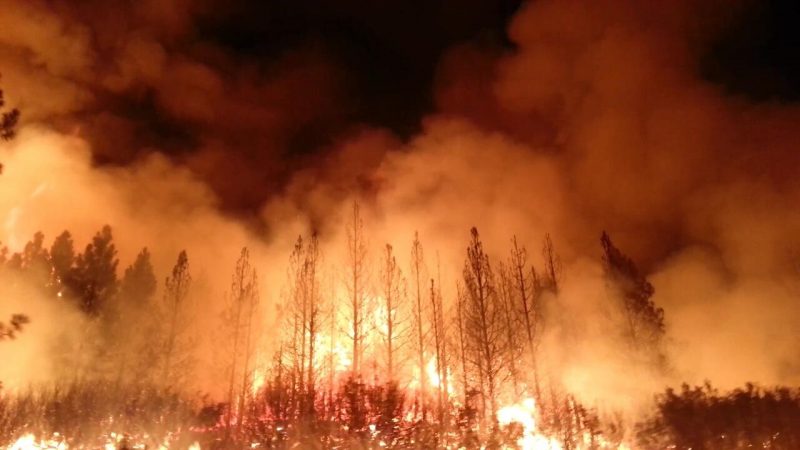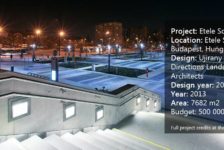On October 8, 2018, the UN released a bombshell report whose implications will shake the profession of landscape architecture to its core. The report lays out clear evidence that if world governments don’t take drastic action to end the fossil fuel era over the next decade, in the very near future humanity will witness severe food shortages, climate related poverty increases, and massive ecological destruction, all leading to unprecedented human migration.
This is ultimate proof of the destructiveness of fossil fuels and the first time we’ve definitively been presented their needed expiration date.
“This report shows that we only have the slimmest of opportunities remaining to avoid unthinkable damage to the climate system that supports life as we know it,” said Amjad Abdulla, an International Panel on Climate Change (IPCC) board member, in a release. Debra Roberts, co-chair of one of the IPCC working groups, is quoted as saying of our situation: “The next few years are probably the most important in our history.”
In order to maintain that slim opportunity, the report argues that the nations of the planet must soon stop burning fossil fuels to keep global temperature from increasing no more than 1.5 Celsius (C) above pre-industrial levels.
If landscape architecture is to be a vital part of the future, this report means that our work, which is now utterly dependent on fossil fuels, must change completely during a time when it will be needed more than ever.
Where things stand now
The planet has already warmed by 1C (approximately 1.8 degrees Fahrenheit) and continues to increase. “Climate change is occurring earlier and more rapidly than expected. Even at the current level of 1C warming, it is painful,” says Johan Rockström, as quoted by The Guardian.
To stay below the 1.5C maximum tolerable temperature increase, global annual carbon dioxide emissions must drop by about half by 2030 and then be at essentially zero by 2050.
Basically, this report says that the world has 12 years to limit climate change catastrophe by rapidly weaning ourselves off fossil fuels
If we do not meet that goal, it is likely that global temperatures will continue to increase by at least 2C. That amount is considered the absolute outer boundary of civilization’s safe operating zone. To not cross that 2C boundary, we must completely stop burning fossil fuels not long after 2050. Thus there is no scenario in which we can continue to burn fossil fuels for much longer anyway.
But we do not want it to get that far. The UN report shows the immensely negative impacts of the difference between 1.5C and 2C warming.
With a 2C temperature increase, instead of 1.5C, sea level rise would affect millions more people. Ocean acidity and oxygen loss would cause 99% of coral reefs to disappear along with much needed food fisheries. Insects, vital for food production, are twice as likely to lose half their habitat at a 2C increase.
An increase to 2C would add more extremely hot days in summer, which would cause more forest fires and heat related deaths. Global population exposed to water stress could be 50% higher at 2C, and millions more people would be at risk of greater food scarcity and climate-related poverty.
Finally, an increase of 2C means that there is the possibility that large areas of permafrost will thaw, which would release more carbon dioxide into the atmosphere, leading to runaway climate change which might not be survivable.
It should be frighteningly clear, then, that while a 1.5C increase is dangerous, the impacts of 2C or even higher global temperatures are absolutely terrifying.

People displaced by drought in Somalia arrive at the Dolo Ado camp in neighbouring Ethiopia and queue to be registered by the aid agencies running the camp. | Photo: DFID – UK Department for International Development
What it means for landscape architecture
To avoid that 2C future, the world needs “rapid and far-reaching” changes in energy systems, land use, city and industrial design, transportation and building use according to the report.
It is here that the report speaks to landscape architects. Those “rapid and far reaching” changes mean that within 12 years our profession must use 45% less fossil fuels than currently, and no fossil fuels at all within 30 years.
Landscape architects, like most professions and our whole society, are absolutely unprepared for this reality. For us, not being able to use fossil fuels will radically alter the materials and construction methods we take for granted. This in turn will have dramatic implications for design and professional practice.
For example, there will be little concrete and steel in a zero fossil fuel world, as they not only require fossil fuels for their creation, but their manufacture expels carbon dioxide. Ironically, this will also mean not being able to use those materials in efforts to adapt, say, to the effects of climate change. (Read more here)
Perhaps more importantly, building our projects without using fossil fuels will demand of us not only a new creativity, but also honesty and equity in how that is accomplished.
There appears to be little hope in technology scaling up fast enough to let us continue to burn fossil fuels without consequences. Nor is it likely that we can continue to use fossil fuels but attempt to offset them in some way by planting trees or geo-engineering, for example. This report shuts the door on wishful thinking.
It is possible, of course, that we as a profession will choose not to eliminate fossil fuels from our work. The argument might be that if the rest of the world does not, how can we?
However, if landscape architecture is to grow in relevance in the coming years, we cannot continue to be complicit in what is now unmistakably the destruction of the only ecosystem in which we can live. We must lead by example if we are to survive. To do that, it is urgent that landscape architects begin a discussion of what it will mean for us to be fossil fuel free.
—
Lead Image: The Rim Fire in the Stanislaus National Forest near in California began on Aug. 17, 2013 and is under investigation. The fire has consumed approximately 149, 780 acres and is 15% contained. U.S. Forest Service photo.











Pingback: Sobering Reports on Climate Change impacting Landscape Architecture | Terrain Integration
Martin Arredondo
I am curious to know how many LA’s either “believe” or “deny” these claims. I do not believe it (especially from the IPCC and the UN). I don’t subscribe to the “doom and gloom” per these predictions. I’ve been around long enough to see too many “predictions” come and go with no effect. Of course, we should all be good stewards of the Earth and landscape and including design, we have an opportunity to make things better. Surely planting 1000 trees would make the world a better place. But, no, I don’t believe that the use of fossil fuels etc. is the cause sea level rise, “global warming”, and/or “climate change.” If I admit something like that in a job interview I can assure you that I will not be a candidate for hire at a prestigious LA firm because of my “beliefs” nor will I rise to any highlighted position, grace the cover of ASLA’s Landscape Architecture Magazine, or offered a rewarding contract or project. It’s not going to happen. So, in the end, I’m merely trying to point out the thought in that I won’t be accepted amongst my peers because I’m not a staunch supporter of the “global warming” or “climate change” crusade. I can guarantee you that anyone admitting that you are a “denier” could likely jeopardize their career path because of it.
Pingback: The climate is changing, and we must change too « Harmony Gardens
J. Robert (Bob) Wainner
I agree with “Martin” above. For one, I’m not convinced that increased CO2 into the Earth’s atmosphere has any direct correlation to “climate change”. As we all know, the Earth has basically been doing “it’s thing” with regards to weather….changing for Millions of years, since the very beginning. I did the research…the Earth’s atmosphere consists of .04% CO2…or as the experts like to say, 400 ppm. I’ve read, that experts do agree…that a warmer Earth is better than a cooler one….for both people and animal life.
Funny to watch an interview with a NASA Astronaut the other night. He said, “Well, if you have a problem with the amount of CO2 on Earth, you’re not going to like the CO2 levels on the planet MARS”. He was asked about the possibility of humans settling on Mars (if Earth were to become uninhabitable). Mars’ atmosphere has over 90% CO2. He went on to state that in his professional opinion, we’re over 1,000 years away from being able to live on MARS. If we ever do make it to Mars, we most likely would be living under ground, in bunkers (where we would need to generate our own Oxygen).
But, back to the Earth. It’s a fact, that “cows” and “active volcanoes” emit more CO2 emissions than ALL of the cars and trucks on our planet put together.. And, the U.S. is doing a better job of curbing CO2 than nearly all of the other Nations. Go visit China, India, South Korea, etc…..you can’t even breath their air or see the city skylines. In Seoul, South Korea, the Gov’t shut down 650 downtown parking lots (to force workers to use mass transportation) due to very high levels of toxic air. STILL…..don’t know why I’m even talking about CO2…..yes, it definitely causes terrible “air pollution”…but, WHY are people so convinced CO2 (and people) are causing “climate change”???
Even IF the air quality in the U.S. was 100% pure…….wouldn’t matter. There are so many other Nations with awful air quality & high CO2 levels….the jet streams bring their BAD air to the U.S. Going with ALL “Electric” vehicles isn’t the answer either. If everyone drove an Electric car, think what that would do to the U.S. “power grid”. We would be very vulnerable to attack by a foreign Nation. And, our power grid would be stretched to the point where we would have constant “power outages”. Tesla believes they have a great car….but, OK, maybe I’m a bit old school, but, IMO, we are just not ready for “Electric” or “Hybrid” cars/trucks. And, pricing a “new” Tesla, even their new compact (and compact cars are not selling due to lower gasoline prices)…Tesla’s are priced from about $78k to $120k…..thanks, I’ll pass.
And, WHAT does “Climate Change” have to do with “Landscape Architecture”? Nothing, IMO. Oh, I’m sure there are several Liberal University Professors who think they have the answer…..don’t think so. The “green energy” movement under former President Obama was seriously flawed, IMO. Way too much regulation, that hurt our economy and businesses in America. I think so much of all of that was about the “money”….a multi-Billion industry….and an experiment at that…didn’t work.
I’m just NOT buying the concept that “humans” are in any way causing “Climate” to change here on Earth. Yes, humans are contributing to air and water pollution, for sure. But, every Nation should be financially responsible for cleaning up their own mess…..that’s why I was glad to see President Trump pull the U.S. out of the Paris Agreement.
J. Robert (Bob) Wainner
Pingback: Is that a light or a train? « Harmony Gardens